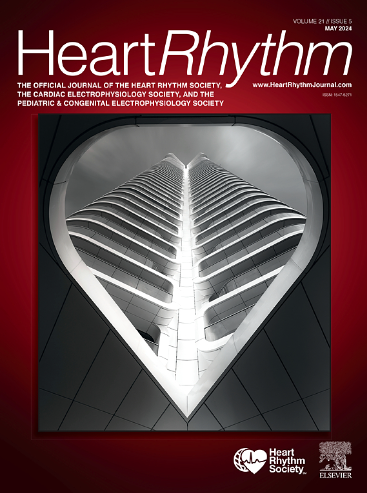Risk of recurrent ventricular tachyarrhythmia following the occurrence of a first ventricular arrhythmic event in patients with a primary prevention implantable cardioverter-defibrillator
IF 5.7
2区 医学
Q1 CARDIAC & CARDIOVASCULAR SYSTEMS
引用次数: 0
Abstract
Background
There are limited data on clinical and arrhythmic outcomes after a first ventricular tachyarrhythmia (VTA) in heart failure (HF) patients who receive a primary prevention implantable cardioverter-defibrillator (ICD).
Objective
This study was designed to quantify the burden of and to identify risk factors for recurrent VTA in this population and to evaluate the risk of all-cause mortality associated with recurrent VTA.
Methods
The study comprised 789 patients who experienced VTA following primary prevention ICD implantation in 5 ICD trials (MADIT-II, MADIT-RISK, MADIT-CRT, MADIT-RIT, RAID). Landmark analysis was used to quantify the burden and to identify predictors of recurrent VTA. Time-dependent analysis was used to evaluate the association of VTA recurrence with subsequent mortality.
Results
The mean age of the study patients was 63 years, and 17% were women. The cumulative probability of experiencing at least 1 recurrent VTA episode at 3 years after a first VTA episode was 60%; the recurrent VTA burden after a first event during 3 years was 2.8 episodes per patient. The risk of recurrent VTA remained ≥56% at 3 years regardless of baseline clinical and echocardiographic risk factors. VTA recurrence was associated with a significant 2-fold increased risk of subsequent all-cause mortality.
Conclusion
Patients with a primary prevention ICD who experience an episode of VTA are at high risk of recurrent VTA, regardless of baseline risk factors. Recurrent VTA is associated with a pronounced increase in the risk of death. These findings suggest a need for early intervention after a first VTA in patients who receive a primary prevention ICD.
使用一级预防植入式心律转复除颤器的患者发生首次室性心律失常事件后复发室性快速性心律失常的风险。
背景:关于接受一级预防植入式心律转复除颤器(ICD)治疗的心力衰竭(HF)患者首次发生室性心动过速(VTA)后的临床和心律失常结果的数据十分有限:量化该人群中复发性 VTA 的负担并确定其风险因素,评估与复发性 VTA 相关的全因死亡风险:研究包括在 5 项 ICD 试验(MADIT-II、MADIT-RISK、MADIT-CRT、MADIT-RIT、RAID)中植入一级预防 ICD 后出现 VTA 的 789 例患者。地标分析用于量化复发性 VTA 的负担并确定其预测因素。时间依赖性分析用于评估VTA复发与后续死亡率的关系:研究患者的平均年龄为 63 岁,17% 为女性。首次VTA发作后3年内至少复发一次的累积概率为60%;首次VTA发作后3年内每位患者的复发率为2.8次。无论基线临床和超声心动图风险因素如何,3年后复发VTA的风险仍≥56%。VTA复发与随后全因死亡风险显著增加2倍有关:结论:无论基线风险因素如何,使用一级预防 ICD 的 VTA 患者复发 VTA 的风险非常高。复发性 VTA 与死亡风险的显著增加有关。这些研究结果表明,接受一级预防 ICD 的患者在首次发生 VTA 后需要及早进行干预。
本文章由计算机程序翻译,如有差异,请以英文原文为准。
求助全文
约1分钟内获得全文
求助全文
来源期刊

Heart rhythm
医学-心血管系统
CiteScore
10.50
自引率
5.50%
发文量
1465
审稿时长
24 days
期刊介绍:
HeartRhythm, the official Journal of the Heart Rhythm Society and the Cardiac Electrophysiology Society, is a unique journal for fundamental discovery and clinical applicability.
HeartRhythm integrates the entire cardiac electrophysiology (EP) community from basic and clinical academic researchers, private practitioners, engineers, allied professionals, industry, and trainees, all of whom are vital and interdependent members of our EP community.
The Heart Rhythm Society is the international leader in science, education, and advocacy for cardiac arrhythmia professionals and patients, and the primary information resource on heart rhythm disorders. Its mission is to improve the care of patients by promoting research, education, and optimal health care policies and standards.
 求助内容:
求助内容: 应助结果提醒方式:
应助结果提醒方式:


